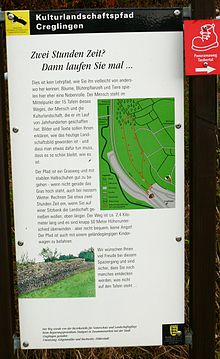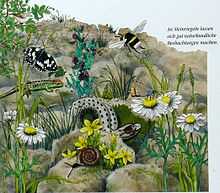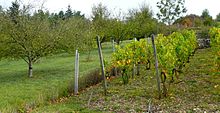Creglingen cultural landscape path
The Creglingen cultural landscape path leads for 2.4 km over steep slopes that were once cultivated by humans , on which, in the past, wine was grown , arable farming and animals were grazed . It begins above the Creglingen tourist information office on the road to Bad Mergentheim and takes about two hours 50 meters above the landscape.
History / description
The path was inaugurated in April 2004. On more than ten information boards, it explains how every square meter of land used to be used for the production of food. Stacked stone walls and stone bars were important.
Nature and culture in perfect harmony
The hillside landscape around Creglingen appears to be of natural origin , but the hillside at the vineyard is a man-made cultural landscape . Generations of Creglinger farmers, especially the wine growers - called "Wengerter" or "Häcker" - have left their mark.
“For around eight centuries the route was a vineyard or" hackland "(potatoes, beets, etc.), then an orchard or meadow. ... Many properties have become "care cases". ... A beautiful landscape is either preserved through (agricultural) cultivation or has to be "cared for". ... It has to be preserved here, where it is still beautiful. "
Memories of old times
In the old days the whole family went to the vineyard. When the snow melted, walls had to be repaired. The earth that was washed away was carried back upstairs in baskets. In the spring, stakes had to be driven into the ground, vines cut and tied. In summer, weeds were weeded, the soil loosened and sulfur and vitriol broth were sprayed against pests. Hail or frost could suddenly destroy the work of the people. The grapes were harvested in October - then there was life in the vineyard, where cows pulled the carts back then. Then they untied the vines from the sticks, laid them on the ground and covered them with dung and stones against the frost. In the years around 1930 the decline of viticulture began. Pests like phylloxera were one reason, and it was easier to produce wine elsewhere. The Wengerters now had to make a living in agriculture or industry. Some even emigrated.
Ornate buildings made of stones
The dry stone walls on the edge of the path are made of shell limestone , which is 230 million years old. The stones were broken and hewn in the landscape, then they were driven to the slopes and set up as small works of art that stood firmly without mortar. Some of the walls on this path are hundreds of years old. The "back wall" made of small stones behind the visible wall diverts the water so that the frost in winter does not burst the wall.
Stone bolt
Like a pile of dead stones - this is what a stone bar looks like at first glance. But it is a habitat for animals and plants: spiders , woodlice , lizards , fire salamanders , smooth snakes and slow worms as well as lichens , mosses , grasses and thick-leaf plants ( stonecrop ). Blackberries , barberries and swallow's root, as well as native songbirds , also grow on the edges of the stone bar. E.g. the red backs romp here.
Cultivated landscape maintenance
The plots along the cultural landscape path are mowed once a year. In doing so, you also remove bushes and wild tree vines so that the slope and the entire Taubertal do not gradually become bushy and later turn into a forest. Whenever possible, small islands are left out when mowing. Insects can hibernate in the stems of the plants and partridges and hares have cover. But the landscape should remain open. Therefore the city, the district and the country spend money on landscape maintenance.
Stone bolt
In a stone bar that is 250 meters long, 15 meters wide and three meters high at the highest point, there are roughly 60 million stones. The inside has an earth core . Between the bars, where the stone cover is missing, the ground has sunk - by collecting the stones themselves and by natural soil erosion .
Landscape in the Taubertal
From the height of the landscape path you can see a landscape like from a picture book. “The ideal landscape for animals, plants and hikers,” reads the information board. Hedges move over the slopes, they hold off the wind, prevent the soil from being washed away too much into the valley, and give the landscape its character. Birds, deer , rabbits and other animals feel at home here because they can quickly move from one cover to another in the networked landscape. A bank follows the brook and river in the valley, winding as nature created them. The water flows off more slowly over the sweeping loops .
Cultural landscape is changing
"Meadow plots that are kept clear with tractor, bar mower and brush cutter, the last vineyard here on the slope, two orchard plots and now the forest - here you can see all forms of use that characterize this landscape in a very small space."
Wine grows in the vineyard of the cultural landscape path, behind it is a dry stone wall. An orchard is tended right next to it . A few meters further a forest has been reforested and natural wood has settled.
Sheep in the pasture
Above the hiking trail you come to the open corridor of the hilltop. Until 1940, sheep and goats grazed on the upper slope of the Taubertal . Now that the animals no longer nibble off the fresh green, wasteland spreads here . But during the summer it blooms all over the area. In some places you can see pits almost filled in - they were quarries from which the stones for the dry stone walls come.
Upper slope edge
The Muschelkalkfels looks out through the thin vegetation of the strip of heather over vineyards and sheep pastures. So that sheep and goats did not eat the fruit in the vineyards or fields, they had to be looked after. Sloe , dogwood and hazel bushes grow today on this slope section. If the landscape were not cared for here, then in 50 years there would be a contiguous forest. And then no heather would grow here, especially no more Carthusian carnations . Sometimes farmers store wood and stones on this meager ground; that doesn't harm the landscape. But when sawdust, dung and other rubbish are dumped, nettles and blackberries soon begin to grow in the sun.
Wild roses
On the heather area above the Taubertal, wild roses thrive on the heather strip of the barren, dry limestone soil - especially wine roses , beaver nell roses and dog roses .
Hardship with carts on steep paths
The way back from the edge of the slope above the vineyard to the starting point of the cultural landscape path leads along a path that used to be very busy between the fields on the edge of the slope and the Tauber Bridge. The way up was difficult for the carts , but going down was by no means easier. The car had to be prevented from rolling downwards in an uncontrolled manner so that it did not hit the draft animals. There were no brakes , so you had to lock the wheels with a piece of wood or put cycling shoes under them. Then the wheels could not turn - and the animals also had to pull the wagon down, as if on skis . If you drive your way up or down in a motorized way today, you hardly suspect how laborious it used to be.
Individual evidence
- ↑ Information board "An old Creglinger reports" on the cultural landscape path
- ↑ Information board "There were a lot of stones ..." on the cultural landscape path
- ↑ Information board "Habitat Steinriegel" on the cultural landscape path
- ↑ Information board "Landscape conservation safeguards the cultural landscape" on the cultural landscape path
- ↑ Information board "60 million stones" on the cultural landscape path
- ↑ Information board "Much landscape ..." on the cultural landscape path
- ↑ Information board "On the change in the cultural landscape" on the cultural landscape path
- ↑ Information board "Where sheep once grazed ..." on the cultural landscape path
- ↑ Information board "Along the slope edge ..." on the cultural landscape path
- ↑ Information board "Painful on the fabric of the pants ..." on the cultural landscape path
- ↑ Information board "On old ways" on the cultural landscape path
Further cultural landscape paths
- Gnadental cultural landscape path (Michelfeld) (PDF; 7.1 MB)
- Schwalm cultural landscape path in Willingshausen
- Königswalde cultural landscape path
- Project "Cultural Landscape Path" at the Gymnasium am Geroweiher Mönchengladbach (PDF; 4.1 MB)
- Hardtseen and Heilsberg cultural landscape path







